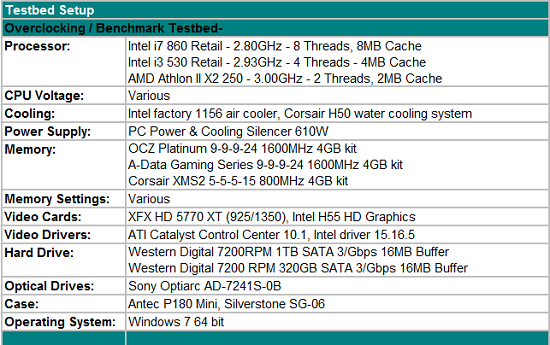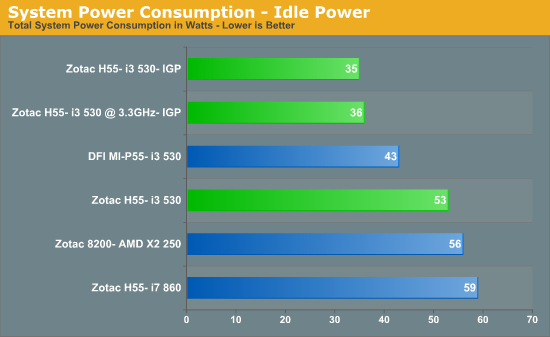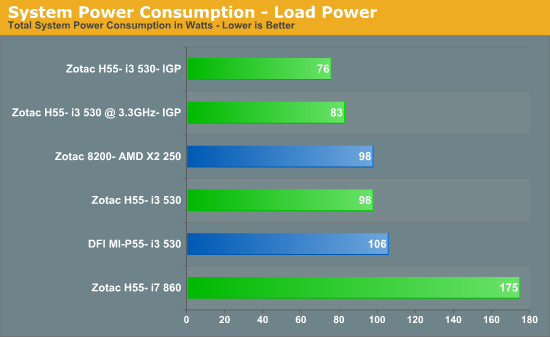Zotac H55-ITX Review - The World's First mini-ITX H55 Motherboard
by Joshua Youngberg on February 28, 2010 12:00 AM EST- Posted in
- Motherboards
Testbed Setup

We used 2x2GB 1600MHz memory kits from A-Data and OCZ to test the memory compatibility of ZOTAC’s newest motherboard. The operating system was installed on a 320GB WD hard drive while the applications were stored by a 1TB WD hard drive. A fresh installation of Windows 7 64-bit was applied to every motherboard before testing.
Intel’s factory heatsink handled the processor cooling duties at the factory frequencies. During overclocking we used a Corsair H50 Hydro cooler to cool the processor although it was hardly needed.
When testing the ZOTAC 8200-ITX we relied on the nVidia chipset for graphics. The H55-ITX used an overclocked XFX 5770 for all tests except where noted. We used the same XFX HD 5770 for all of the DFI MI-P55 tests as well.
While testing the Intel-based motherboards we tried to keep the DDR3 timings as similar as possible. Unfortunately, due to a bug in the H55-ITX BIOS we had to run the CAS latency at 10. Memory frequency on these boards was set at 1333MHz due to fact that the i3 530 does not natively support 1600MHz RAM. Interestingly, the BIOS on the H55-ITX has an option for 1600MHz but choosing it prevents the system from POSTing. However, when the i3 530 was overclocked the memory frequency was bumped up to 1500MHz while using the same timings.
We used two ZOTAC motherboards for our wireless performance test. Our review motherboard, the H55-ITX, has wireless-n capabilities while the other board, the ZOTAC 8200-ITX, uses the older wireless-g standard. We measured the time it took both test systems to transfer a 1GB movie file. In order to simulate a typical HTPC environment the test systems were separated from the wireless-n router by thirty feet and two insulated walls.
For our lone AMD board all benchmarks were run using 4GB of 800MHz DDR2. The main RAM timings were set at 5-5-5-15 while any additional sub timings were left on auto.
We ran two sets of gaming benchmarks on the H55-ITX motherboard. One set uses Intel’s HD graphics while the other uses a HD 5770 from XFX. We have included these to demonstrate the viability of using i3 530’s integrated GPU for graphics.
Power Consumption
For our system power consumption tests we measure the watts being pulled out from the wall socket by the entire system. Keep in mind that power consumption at the wall can vary for a specific system based on the efficiency of the power supply being used. For these tests every power saving option in the BIOSes were turned on.


The Zotac H55-ITX put down some of the lowest idle power consumption numbers that I have ever recorded on a desktop. System consumption under 100% CPU load was very mild as well. Numbers this low would make the H55-ITX ideal for a system that is rarely shutdown, like a HTPC.










69 Comments
View All Comments
YellowWing - Monday, March 1, 2010 - link
It happened to me too this morning, going from page to page. Looked to me like nasty malware.ggathagan - Sunday, February 28, 2010 - link
Since you are now putting the performance summary at the beginning of the article, you need to make sure you also make note of relevant system details at that point.For instance, the performance graph doesn't make note of what add-in graphics card was used. You have to get 5 pages into the review before that information is supplied.
Other than that, good article.
ScavengerLX - Sunday, February 28, 2010 - link
Thanks for the discussion on power consumption guys. Ideally, this system would work best with a low wattage (~200W) power supply that had better efficiency under 75W.Joshua
yyrkoon - Monday, March 1, 2010 - link
Jashua, Sparkle makes just such a PSU. Well actually, its 220W but an 80Plus PSU.---> http://www.silentpcreview.com/article773-page1.htm...">http://www.silentpcreview.com/article773-page1.htm...
However, 220W, or even 200W is still over kill. Unless you go with discrete graphics. In which case an nVidia 9600GT, or larger in this system would draw too much power for it to handle.
My Core 2 system with 4GB 1.8v memory, and a 9600GT peaks around 226W in some games. Generally, those games that make most use of the GPU and CPU. Such as world in conflict. These number do include a 19" WS LCD monitor too, but it only uses 23W consistently.
Anyways, as another has already mentioned, any PSU is best loaded at 50% capacity for the best efficiency. Especially 80Plus PSUs. SO with IGP, and the i3, that would be ~150W. Good luck finding such a beast. And before any car enthusiast start mentioning these pico supplies . . . they are junk, and often not powerful enough to begin with( for this application ).
strikeback03 - Tuesday, March 2, 2010 - link
The pico PSUs would probably be fine if you weren't using a discrete GPU.ScavengerLX - Monday, March 1, 2010 - link
Thanks for the link.Actually the PSU that comes with a Silverstone SG06 is nice, too. 300W, 80+ and SFX form factor. That case would be nice for the ZOTAC H55 + Discrete system.
Joshua
juampavalverde - Sunday, February 28, 2010 - link
After seeing the pictures of the board, almost instantly i tought.. with that small space such powerful htpc... it wont be hard to fit an i3+h55 inside an ultraportable or netbook like, and the thing would be freakin fast in comparison with the atoms!mschira - Sunday, February 28, 2010 - link
Hm, interesting board.I wonder if it would make sense to slot a fast RAID card into the PCI slot and a small Core i3 integrated VGA CPU and build a decent Linux mostly file centric server.
Comments?
Cheers
M.
nikclev - Monday, March 1, 2010 - link
I suppose it would depend on the particulars, but for a linux file centric server I'd skip the raid card unless you need more than 6 sata drives or need to leave the cpu free for other tasks. Just use software raid.In a way, this -IS- hardware raid, just not in the traditional sense. In effect, a decent hardware raid card is nothing more than a processor, some cache ram, a pci/pcie to sata interface, and perhaps a battery. All of these things can be duplicated without the card.
The i3 becomes your raid processor, it happens to be much more powerful than you need for this application. (so you have room to do other tasks as well.)
The system ram becomes your cache ram, (again, more than you need, so there is room for other tasks)
and so on. Cap it off with an appropriate sized ups, and you have a nice home raid server (with no raid card!) with all the features that you would get in a midrange hardware raid card, and the ability to do a great deal more.
All in all, a fun project. One thing to note: if you just want a decent speed home NAS, it's cheaper to either use microATX or purchase a Qnap/synology/etc pre-made. Not nearly as much fun though. :)
Nick
michal1980 - Sunday, February 28, 2010 - link
your power supply is over kill, waste too much energy no matter the efficency.